Pumping height explained
Each pump we sell has a chart showing maximum pumping height and litres per hour flow at different head or pumping heights.
The information below is intended explain these calculations.
"Head" Or maximum pumping height (Zero flow height)
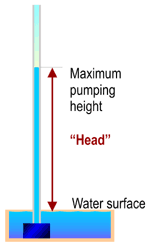
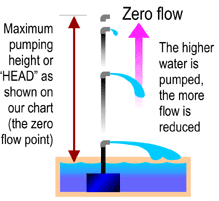
Head is also known as the "No flow or zero flow height", "Lift" "shut off" etc, The point at which nothing comes out of a tube. It does not matter what size tube* is used, this height is the same. *The flow is however effected by the tube internal diameter.
Vertical lift
For a given pump, the higher water is pumped vertically - the lower the flow; at a some height the flow will be zero. The terms "head height" or "lift" are used to indicate this vertical height, measuring how high the water can be pumped for a particular application. Each pump has a published graph showing its flow rate at various heads. Waterfalls or streams have the added factor of friction loss created by the longer hose run required between the pump and the top of the waterfall or stream.
Static head Why is the height from the pump to the top of the water not counted in the head calculations?. It's called Static head. It does not count as pumping height because the water is already at the surface and does not have to be pumped there.
Maximum depth the pump can be located. depending on the pump there is a maximum depth that a pump will operate. The larger the pump the deeper it's suitable placement. Call us for help if you are planning a pump depth over 1.5m
Pumping height
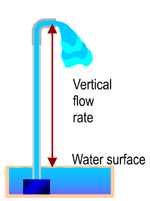
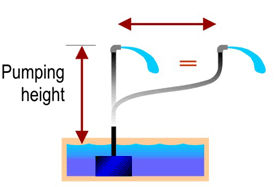
Horizontal flow (tube friction)
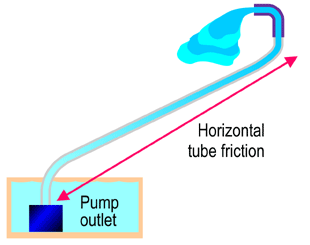
In calculating tube friction, the entire tube length must be used.
Friction loss - for waterfall or stream use.
Pumping water through tubing adds resistance, so an allowance must be made for friction loss inside the tube. As a rule of thumb add 10cm of head for every 1 meter of horizontal tubing run. However as the size of the tubing has a significant bearing on frictional resistance, the use of an undersize tube will increase frictional losses.
An allowance for friction loss must be added to the vertical distance (in meters) measured from the surface of the pond, over which you will be pumping the water. The resulting sum will be the 'Total Head' that the pump will be required to lift the water. You should compare the flow rate that you require, to the flow rate that the pump provides at this specific head. Feel free to call us on 1800 607 388 if you need assistance calculating tube friction loss.
